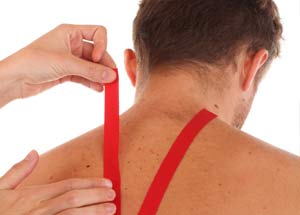
Myofascial taping

Myofasscial taping system for relief and support of the knee.
What is Myofascial Taping?
Myofascial taping is an innovative fascia taping technique through which pain, dysfunction and injuries in the musculoskeletal system (muscles, tissues and joints), as well as shortening and restricted movement can often be quickly treated and eliminated.
For this purpose, a self-adhesive and highly flexible cotton tape is applied to the skin according to the fascial course. The tape does not restrict movement, but facilitates and improves it. The tapes are dermatolgically tested and usually last between four and seven days or even longer. Since you can do sports, shower and swim with the tape on your skin, they do not restrict your daily routine and everyday life.
The main result of fascia taping is an immediate improvement of pain symptoms and a shortening of healing phases.
I use exclusively Flexotape® which is quite expensive compared to many kinesiotapes, but seems to me to be the best in terms of quality, and was developed specifically for myofascial taping techniques.
Myofascial taping is often and gladly applied at the end of a treatment to support and maintain the treatment progress until the next appointment. However, it is quite possible to apply fascia taping without prior body therapy treatment, especially for quick relief of pain, tension and injuries.
However, for a lasting effect and improvement of symptoms, I always recommend taping in conjunction with a previous myofascial connective tissue massage(rebalancing).
Fields of application
- muscular pain and tension
- Back pain (lumbar spine, thoracic spine syndrome)
- Herniated disc (disc hernia)
- Shoulder and neck tension (cervical spine syndrome, whiplash)
- Heel spur
- Osteoarthritis and joint pain
- Rib fractures (to improve breathing)
- Pregnancy (to relieve the back)
- Acceleration of the recovery process in case of surgery (e.g. artificial knee or hip joint)
- Tinnitus
- Scolioses
- Headache and migraine
- Treatment of scars
- Improvement of the lymph flow (especially after surgery and injuries through lymph taping)
- Improvement and facilitation of movement patterns (also sport-specific),
and much more.

Pain star with fascia tape e.g. for back pain, tension or slipped discs
History of the development of Myofascial Taping
Myofascial taping is a fascia taping method developed by Markus Erhard (Physio Training Academy) based on the latest findings in fascia research. Often it is not the muscle that is the cause of pain and physical discomfort, but in almost 80% of seemingly muscular pain, its fascial envelope and the surrounding fasciae.
Markus Erhard developed specific fascia taping techniques that aim to address the properties of the movement and pain receptors of the fascia (Golgi, Pacini, Ruffini and interstitial receptors) via the skin and thus trigger corresponding sensory and fascial effects in the body. These receptors react, for example, to traction, pressure and tension. This gave rise to the taping techniques specific to myofascial taping, such as:
- MRT - Myofascial Release Technique
i.e. where there is too much fascial tension, appropriate taping techniques are used to encourage the fascial tissue to relax and release via the skin and underlying fascial structures. Too much tension is released. - MAC - Myofascial Activation - Technique
i.e. where there is too little fascia tension, the fascia tissue is stimulated to build up tension through the skin using appropriate taping techniques. The fascia and muscle tissue is thereby activated. - Myofascial CENTER technique
i.e. centering and releasing fascial tissue towards a pain point or area to create space, e.g. in case of a herniated disc/disc hernia.
Myofascial taping is therefore, more precisely, a new, innovative fascia taping method, which differs from classic kinesio taping in that in myofascial taping the functional course of the fascia and the latest findings from fascia research are taken into account and "taped" accordingly. Kinesio taping is often still worked and taped according to muscle insertion and origin and with corresponding taping systems.

Fascia tape to relieve tension in the neck area
Mode of action of the Myofascial Taping
Taping on the skin eliminates fascial and muscular imbalances. It is also called "myofascial imbalances" (myo = muscle / fascia = connective tissue). This leads to the expansion and facilitation of movement and movement control, better microcirculation (blood and lymph) and ultimately to pain relief and pain elimination. The mechanisms of action arise from the mechanical processing of the fascia and the resulting biomechanical and neural effects and not because of the color of the tape.
The tape on the skin causes:
- Myoascial release (relaxation of the fasciae)
- Normalization of muscle tone
- Space creation (e.g. in case of compressed vertebrae, joints or intervertebral discs)
- Increasing the microcirculation of blood and lymph
- Stabilization and facilitation of movement (e.g. in case of rib fractures and sports injuries)
Treatment procedure Myofascial Taping
1. brief conversation: personal details, state of health, symptoms and complaints.
2. if necessary, cleaning of the skin with soap suds/francine (skin should be free of grease)
3. localization of myofascial imbalances and, if necessary, movement restrictions
4. application of the fascia tape on the skin
5. final consultation
Treatment duration
Please allow enough time to arrive and for fascia taping.
As a rule, myofascial taping on already degreased skin, with a short preliminary consultation and without prior treatment, takes about 30 minutes. The effective time depends on the size and number of required taping.
The myosfascial taping in connection with or during a body therapy treatment, usually takes between 15-30 minutes, depending on the size and quantity of the taping installations. The time allotted for this will be included in the treatment time, or please plan for an additional approx. 15 minutes to your regularly booked treatment time.


